
Chapter 5: Miscellaneous Escagraphs
 |
Chapter 5: Miscellaneous Escagraphs |
No two escagraphs are identical, not even of the stolid "Trademark/name" kind, so it would be pointless for me to enumerate them or to supply you with a list greater than the three generic kinds (SWEET, LAWFUL and MOVEABLE TYPE) that I mentioned earlier, to assist you in starting to sort out the plethora of escagraphs you will find. They are different enough from one another that every time you find one and think that it is similar to another that has already been labeled, you observe something unique about it that requires a new label. The three I have suggested take their existence from the source that gives them power. If you choose differentiation based on physical differences alone, you soon have as many labels as escagraphs.
I have a list of escagraphs but I have no intention of entering it here. Instead. I am going to mention some escagraphs that anyone who has read a book about them should have encountered.
The next is not so much an actual object as it is the wherewithal for making an escagraph. This escagraph points up the plight of the poet in mid 19th century Paris. Poets hawked their wares door to door and one such poet was arrested for her mendacity. Seigel tells us in his Bohemian Paris[1].
In 1850, another poet ". . . described himself as going about "from village to village, to offer verses, songs, compliments, for festivals, engagements, baptisms, marriages, burials, and other occasions.' He also provided poetic copy for businesses of all kinds, including cake decorators."
The first subdivision of this category contains standard
food items which can be found in the culture's larder every day but to which
writing has been added. Two easily recognizable examples are cakes, to which any
number of congratulatory or well-wishing texts can be added, and text cookies
which are available in novelty bakeries. These escagraphs are used to enhance an
occasion by bringing the hereditary power of sweetness, the magical capacity of
written words and the multiple meanings of which food is capable to the event. Today, a birthday party that does not include a cake escagraph is unusual.
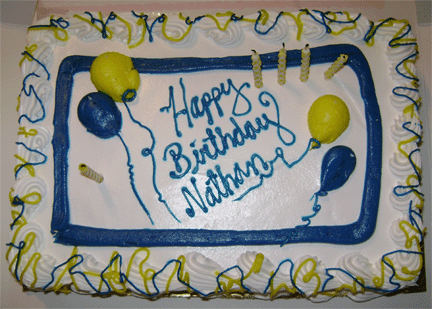
The cake is the perfect standard food item for making an escagraph since it
offers a flat surface to write on and allows plenty of room for text. For
example, the opening of a television station I attended, sported a cake with its
purpose, affiliates and supporting institutions noted in extruded sugar icing on
its top and was further embellished with line drawings of television cameras. They knew I was coming. Birthday cakes began to carry texts in about 1945, but
have a lengthy history before they carried texts. Birthday celebrations, Panati[2]
tell us in his Extraordinary Origins of Everyday Things, date from the
Egyptian Pharaohs of 3,000 b.c., and were adopted by the Greeks who borrowed the
sweet cake from the Persians, established confectioners, for the celebration.
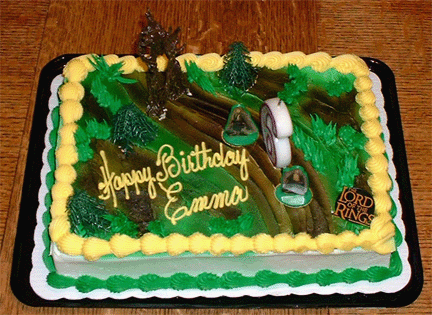
The birthday cake is the one I mention whenever someone needs an escagraph
example they can immediately understand. The birthday cake first acquired
candles in Germany, one more candle than the person was years old. The extra
candle represented life and a candle representing life is well understood by
Anglo culture. Macbeth[3]
speaks of life being a "brief candle" and who could forget Edna St. Vincent
Millay's[4]
"My candle burns at both ends, It will not last the night..." The United States
added music to the birthday cake. The
Happy Birthday song was written by
Mildred and Patty Hill, copyright 1893, originally a song for kindergarten
students called Good Morning To All. In 1924, Robert Coleman added a second
verse, the birthday verse, and it was included in the 1934 musical As Thousands
Cheer which brought the song to national prominence and consequently, resulted
in a lawsuit brought by the Hill's sister Jessica, which she won[2]. The birthday escagraph cake is the only escagraph I have encountered which
includes lights and music.
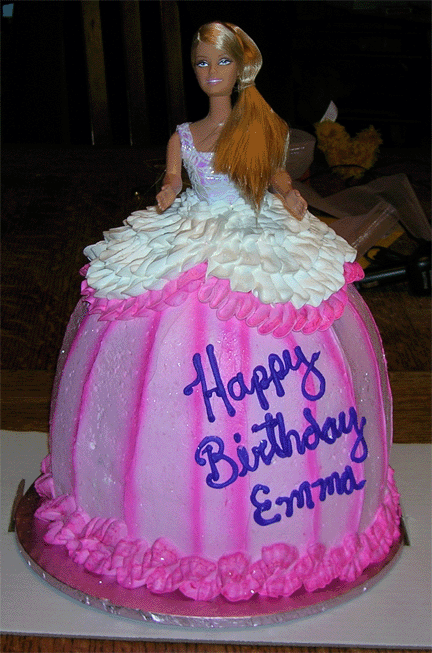
Toasted bread is another standard food item that is used to create an escagraph. Hoan Products Ltd., of New Jersey made something like an ink stamp in the shape of a standard sized piece of bread. When the stamp is pressed onto a slice, it leaves an indentation in the shape of letters and images which spell out and illustrate phrases like "Good Morning" surrounded by rays of a rising sun, or "I Love You" inscribed within a valentine heart. When toasted, the indentations do not brown. Hoan called its product Talking Toast but an examination of their web site indicates that they make the product no longer. With ingenuity, one could make one's own talking toast without much trouble.
Miss Julia Pardoe was a 19th century Englishwoman who traveled extensively keeping diaries. Here is an excerpt[5], written at a time when Franz Liszt was about to return to Pest. Miss Pardoe describes Liszt as a man of about 25 years of age, and, by all accounts, an ethereal creature, tall, slender and dark and much loved by his countrymen. She writes of a shaped escagraph as a sponge biscuit [cookie] in the shape of a grand piano with text which the pastry cooks of the city had created.
Just before the opening of the Carnival, the general cry was for days, "He comes!" until the enthusiasm grew to such height that the whole city was engrossed by one subject. Every Hotel prepared a suite of rooms in the fond hope that theirs might be the proud roof destined to shelter him; print sellers sent to Vienna for engraved portraits of all dimensions of the gifted countryman: extemporaneous antiquaries made researches to verify his genealogy; and even the pastry cooks, unwilling to be excelled in a patriotism which, moreover, promised to be very profitable, invented a new description of sponge-biscuits, shaped like a grand piano, and graced with the name of "Liszt" in spun sugar.
The most labor intensive, and unique escagraph that I have encountered came to me from the Warwick Orchards and Nursery in Ontario, Canada. It is an apple escagraph designed to be given to Warwick's patrons at Christmas. The text is made to appear on the skin of the apple by the manipulation of sunlight. John van Diepen[6] described how Warwick creates its "Merry Christmas" apple:
The message is printed on the fruit with the help of an adhesive stencil, with clear lettering and dark background, allowing the sun to color the fruit in the shape of the letters. The area around the letters does not change color, as the fruit matures, because it covered.
We apply the stickers in July, to well shaped fruit with good shipping and storage life, by hand. After harvesting the apples, the stickers must be removed. We produce approximately 1,000 such apples, each year, not on a commercial scale.
In addition to the "Merry Christmas" text, the Warwick Orchard and Nursery also prepared a "Seasons Greeting" apple and another that read "An Apple for the Teacher." Naturally, any message could be designed for such an escagraph. Shortly after discovering the Warwick apple, I found, in the Summer 1984 edition of Pamona, an article describing the process that Warwick Orchard had used. The Pamona editors suggest writing with a felt pen on scotch tape and fixing that to the apple so that the coloration which van Diepen described would be reversed and would also be in the individualized chirography (handwriting) of the maker.
When I received this apple, I had worked for a couple of years researching and studying escagraphs and was used to their occurrence and appearance. I did not think I could still be riveted by an escagraph. In the escagraphs I had encountered up to then, the labor process involved in its creation were recognizable, even obvious. To be handed an escagraph that had no words printed, extruded or stamped on it, but that had words on it nonetheless, words which were part and parcel of the texture and coloration of this natural object, was arresting. Since written words are an example of man's supreme capability with the symbolic, to see them appearing in the most natural condition on an apple is an eye opener and it fostered in me, as I'm sure it does in anyone who sees it for the first time, a reflection of the language writing process, its symbolism and its capacity to carry meaning. To me, what appeared to be the natural marks on an apple's surface, and they are natural but manipulated, that accomplish the same effect as a carefully typed phrase, was startling. Everything one knows about the ability of writing to capture speech and its meaningful ambiguities, coupled with the knowledge of the labor required to learn how to do it comes tumbling across at you when you read Merry Christmas created by manipulation of natural events on an apple's skin. Lucky the patrons of the Warwick Orchard and Nursery. And, of course, the apple has a sugar content. But, because of its labor intensive production routine, Warwick has discontinued the apple.
Reported in a volume called A Celebration of American Family Folklore sponsored by the Family Folklore Program of the Smithsonian's Festival of American Folklife[7], was a description of an escagraph made in peanut butter. It was contributed by Emily Sardonia, aged 17, Fairfax, Virginia.
Every time we came home from the store with a new jar of peanut butter, my dad, when we would go out of the room, would write the initials of the one he thought had been the best that week. And then the next morning, or whenever we'd go to open the peanut butter to put on our toast or something, he'd call the person, and they'd come running around, and he'd say, "Oh look what's here!" And he would tell us that it was the little fairy that lived in the light downstairs, whose name was Matilda and that she had done it. That used to make you be good so you could get your name in the peanut butter.
Keep in mind that in nearly every brand of peanut butter available in the market, after the first ingredient, peanuts, sugar is the second, and often, 2% of molasses is the third. This peanut butter escagraph points out that this dad in Virginia clearly understood them.
The best known shaped escagraph is the
conversation heart popular during the Valentine season. This small piece of
candy, molded in the traditional valentine shape (a conventionalized and
abstract representation of the two chambers of the human heart) and stamped with
an endearing message like "BE MINE" or a cryptic one like "LATER", is
recognized, understood and treasured by a large segment of our culture. NECCO's
Sweethearts[8]
are the most recognizable of these candies, though
several companies make them.
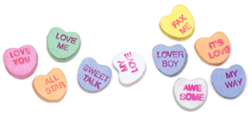
The following account of a parade held when the Federal Constitution was ratified is, unfortunately, without a citation in Alma Austin's work The Romance of Candy[9].
When the Federal Constitution was ratified by the states, parades were held by the various trades. The confectioners fashioned and carried a Bacchus (sic) cup "Made of sugar richly ornamented, four feet, six inches in circumference; sugarplums in the cup; round the goblet's edge the inscription, "The Federal Constitution."
As an Easter specialty, the
R. M. Palmer Candy Company made a six piece train of chocolate in the decade
of the 80s. The cars carried the name and logo of the Santa Fe railroad, the
name "Palmer", and the words "mail car" on the mail car as well as numbers on
the engine and boxcar. We will learn to think of escagraphs as toys as this work
progresses; here is an example of an escagraph that is shaped like a
recognizable toy. R. M. Palmer has discontinued this toy chocolate train.
However, their current line does include
NASCAR
race cars complete with numbers, logos, driver-names and brand-names.
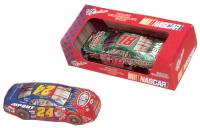
In this small group the writing on food is information about the quality of the food or instructions on how to use the food. So far, I have not found any escagraphs in this division which contain sugar, a condition which bears out the claim that informational escagraphs exist for the principal purpose of informing the consumer and are not to be mistaken for celebratory food items. I have included in this category only those items which are unmistakably food items and not objects ingested for medicinal purposes. The most typical example in this division is the USDA marking on meat which attests to its quality and which is sometimes still readable when the meat reaches the table.
Drugs would be an expected entry in this category but were not included because as edible items with writing on them we are not drawn to drugs as we are to escagraphs. We are drawn to escagraphs in our major or minor celebrations because, by way of them, we bring the powers contained in them (language and sugar) to our celebration. A birthday cake with a HAPPY BIRTHDAY message is a reminder and an acknowledgment of the extraordinary symbolic ability which our development of language is witness to and the sugar propels us into the historical realm of the powerful where we share a moment with Monarchs and Archbishops. The escagraph is an accessory to the celebration because of the symbolism, power and magic it contains. Drug prescriptions are just that, prescribed because of their medicinal content; they are molecular compounds prescribed for the maintenance of our health, the amount of active ingredients, in milligrams, molded or printed on the surface. We do not choose them; we are directed to take them and any magic or power they may seem to contain (words we often use to describe the effect of drugs), have little or nothing to do directly with our capacity as symbolizers. Of course, without our extraordinary ability to reason symbolically we wouldn't have the powerful drugs we do but we don't celebrate that condition when we take an aspirin. We take it to stop a headache. We have seen that it was common to swallow the paper upon which the prescription was written along with the prescribed curative and that cagey physicians used a purgative ink to write their prescriptions thereby giving them an immediate measurable reaction. Drugs encourage us to expect results and temporarily focuses our attention there instead of on our achievements with symbols. Drugs are not used as a direct and open celebration of our ability to symbolize, that is what the escagraph does. The writing on drugs does not excite us the way writing does on an escagraph. Milligram amount of active ingredient is so strongly Informational that the symbolic capacity of the markings (whether words or numbers) becomes transparent, we read it for informational content only. That is why the escagraphs we are examining in the Informational category do not contain sugar.
An example of an informational escagraph, already mentioned in the Trademark/Name category, is disappearing today. It is the ice cream cone, which used to carry the name of the maker (Trademark/Name) and the size of the cup (Informational). The only cone I can find now with writing on it is Kellogg's EAT IT ALL cone which is a registered trademark and not an informational escagraph. I mention it here because I am certain there is an ice cream cone available with the cup size molded into it, I just can't find it.
Keebler (a subsidiary of
Kelloggs) is now producing a cookie with both branded and informational
escagraphs. Their Dipping Delights cookies contain dipping instructions,
such as "DUNK", "DIP", and "MILK POOL".
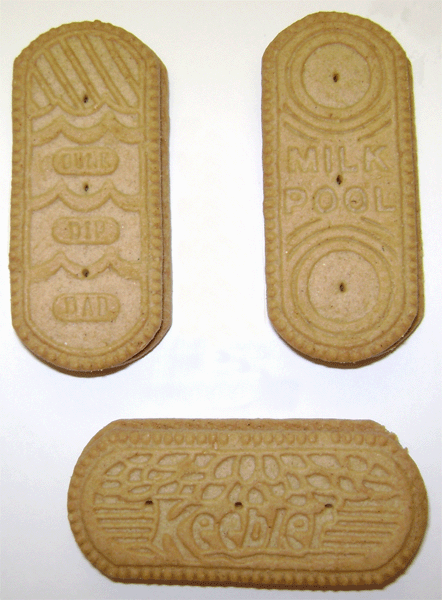
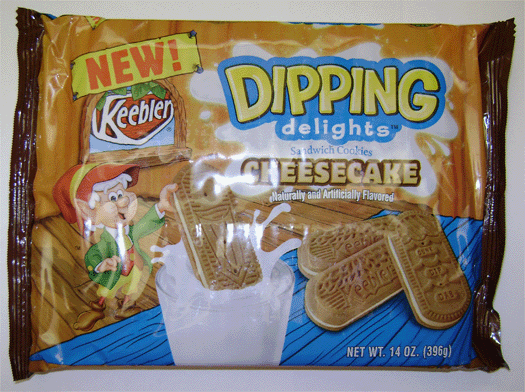
Another cup like example is a Pepperidge Farm puff pastry used as the holder for some form of creamed meat, for example, chicken-ala-king. The pastries are a small cup shape with a lid to them which, after baking, is lifted out so the cup can be filled. To make sure that you remove the correct portion of the cup after baking, the lid originally had a "T" impressed on it to indicate "Top." The "T" was visible when the cup came to the table. Today's Pepperidge Farm pastry Shells have the full word TOP printed on them. If you inadvertently remove the bottom of the cup instead of the top and fill it, your puff pastry will leak.
A variation of the USDA markings on meat is the branded marking which is often
put on a steak at a steak house when you order. The initials "R," "M," or
"W"
can be branded on an uncooked steak by the chef so that the sous-chef knows how
to plate it and the server knows to whom the plate should be delivered. The
brand is still purposefully readable when it is served so as to certify to the
customer that his steak was handled as ordered. A grilling-enthusiasts online
store,
Steak Brands, offers a wide variety of both informational and shaped
escagraphs for searing food.
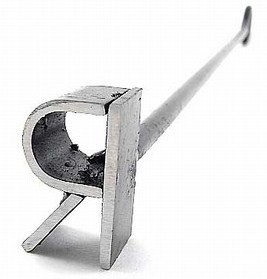
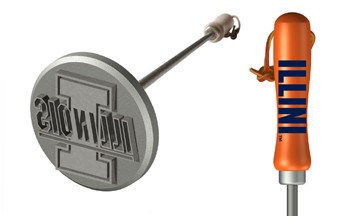
As long as we are branding food items, another branded food shows up in the
Cheyenne, Wyoming restaurant called the Cheyenne Cattle Company. They regularly
brand their baked potatoes with a "CCC" . This brand could conceivably be
informational in the sense that it identifies the potato as a food item of the
restaurant in question but it is also a representative of the Trademark/Name
category.

There is only one type of escagraph in this category and that is food shaped as letters of the alphabet. The main entries (by amount manufactured) are: alphabet pasta, alphabet cereals and alphabet candy and cookies. They could be included under the shaped escagraph category but the fact that these escagraphs are in the alphabet shape, are made by the tons each year, and are largely without sugar, gives them a category all their own. Alphabet pasta is by far the largest variety of Letterform escagraph.
Today, the makers of sugarless alphabet escagraphs have children as their principle market, that is to say, parents who buy them for their children. Children seem the most likely consumers for the tons of alphabet pasta (e.g. in alphabet soup) made in this country. Alphabet pasta increases skill in letter recognition which is beneficial to reading readiness and it also allows us to "play" with the concept of literacy since one of the first behaviors of an adult when presented with a spread of spilled out alphabet pasta is to begin to make words - some adults prefer instead to sort them into their 26 categories. Bags of alphabet pasta also contain the numerals.
Alphabet letters made with sugar are alphabet cereals, cookies and chocolates
available during the valentine season to spell out whatever word you want to
transmit to the person you love. The film
Anger Management, made in 2002 and directed by Peter Segal, uses Alphabit
cereal to make the point to a person undergoing anger management to "CHILL"
spelled out in
Alphabits floating in milk. Post (a subsidiary of
Kraft Foods), who make Alphabits, used their cereal to spell out the name of
monsters in a cereal bowl and encouraged kids to eat them because that would
give them control over the beasts. That advertisement rolls into one all I have
claimed for the magic of writing, the ability of language to carry extraneous
meaning and the extraordinary power which sugar carries. Every kitchen gadget
store has alphabet cookie cutters for parents who want to make alphabet cookies
at home for their kids.
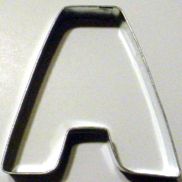
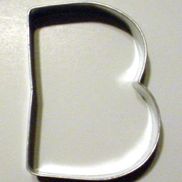
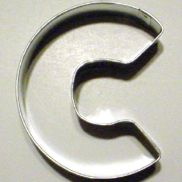
One example of alphabet cookies I encountered makes them politically important.
The
Bahlsen Company in the Germany makes a 100 gram bag of cocoa letter
biscuits. The name of the cookie, on the front of the bag, is in French,
English, Italian, Russian, German and Spanish. The list of ingredients is also
listed in those languages in order to comply with international trade
regulations. All the languages listed, except Russian, make use of the Roman
alphabet. Curiously, the ingredients are also listed in Arabic. This tells us
that the German company which makes them also expects sales in the Middle East
where an Arabic alphabet is used. Why would these rather tasteless cookies have
such a wide market, especially an Arab market, except that they are a learning
device not only for children in countries where a Roman alphabet is used but
also for people who may be learning English because it is the international
language of trade, politics and technology.
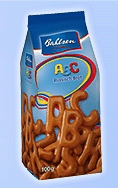
home - links - table of contents - copyright - contact us - author
Copyright (c) 2007 - 2021 North6 Ltd.